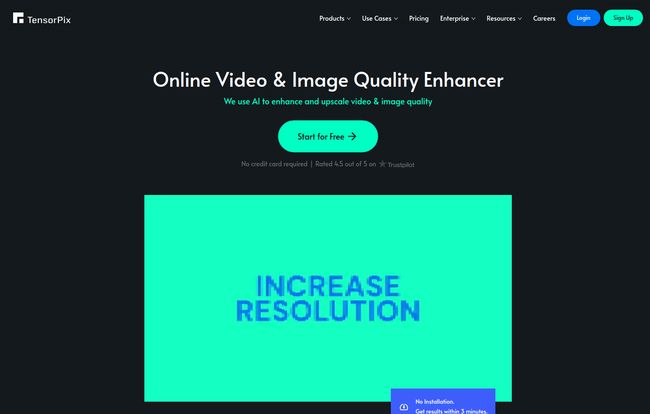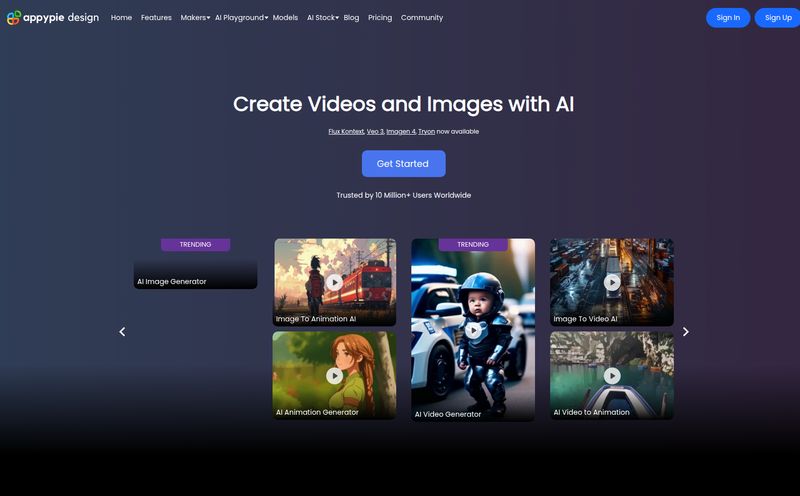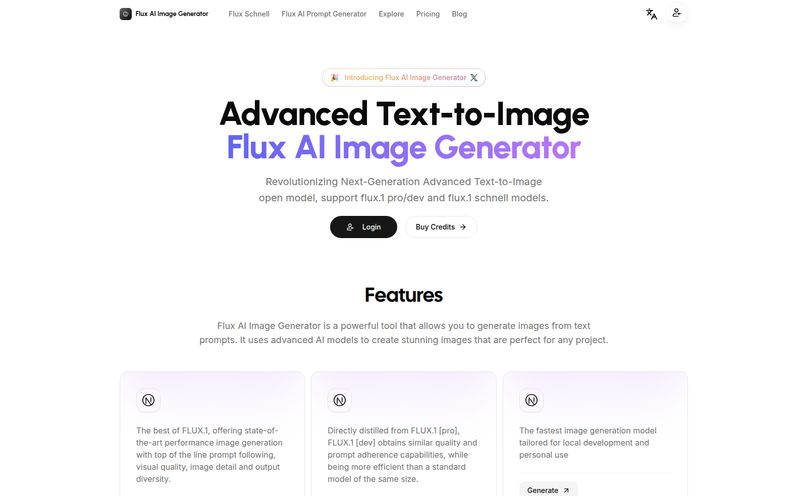We’ve all been there. You find a digital goldmine—a video from a family vacation in ‘08, a clip from your first band's gig, or just a really important Zoom recording. The problem? It looks like it was filmed on a potato. It's pixelated, blurry, and just… sad. For years, the fix was either ridiculously expensive software with a learning curve steeper than Mount Everest, or just accepting your fate. I’ve spent more hours than I care to admit in Adobe After Effects, wrestling with noise reduction plugins and getting mediocre results.
So when another “AI-powered video enhancer” lands on my desk, my skepticism is already cranked to eleven. We've seen so many of these tools pop up, promising miracles and delivering… not much. But then I started hearing whispers about TensorPix from some folks I trust. Even saw that big names like Adobe and L'Oréal were listed as users. So, I pushed my cynicism aside, grabbed a coffee, and decided to see if this was finally the one. Is it just another drop in the AI bucket, or is it the simple, powerful tool we've actually been waiting for?
What Exactly is TensorPix? (And Why Should You Care?)
In the simplest terms, TensorPix is an online AI tool designed to make your videos and images look better. That's it. No fluff. It’s a video enhancer, an image upscaler, and even has a few other tricks up its sleeve. The biggest deal here is that it’s entirely cloud-based. You don't install anything. You just go to their website, upload your sad-looking file, and let their army of powerful computers (specifically, high-end GPUs that most of us can't afford) do the heavy lifting.
This is a game-changer for me. It means I don't have to listen to my laptop's fan scream for mercy while it tries to render a 3-minute clip for two hours. Instead, I can just let the cloud handle it and get a notification when it's done, usually in just a few minutes. It feels like outsourcing the most annoying part of video editing.

Visit TensorPix
A Look Under the Hood: The Core Features
TensorPix isn't a one-trick pony. It's more like a focused digital toolkit for media restoration. Let's break down the main components.
The AI Video Enhancer: The Main Event
This is the star of the show. We're talking about taking that grainy, low-resolution footage and giving it a new lease on life. The AI models here are trained to do a few things really well: increase resolution (upscaling), remove that fuzzy digital noise, clean up compression artifacts, and even stabilize shaky footage. I think of it as a digital art restorer for video. It's not going to invent details that were never there, but it does a shockingly good job of clarifying what is there, just hidden under layers of digital grime. It's perfect for breathing life back into old home movies or making user-generated content look more professional.
The AI Image Enhancer & Generator
The same magic applies to still photos. Found an old scanned family portrait that’s a bit faded and blurry? This is your tool. It sharpens faces, enhances details, and can upscale smaller images for printing without them looking like a pixelated mess. The AI Image Generator is a cool bonus, too. While not its main purpose, it's handy for whipping up some quick concept art or a unique background texture if you're in a creative pinch.
The Often-Overlooked Heroes: Video Compressor & API
Honestly, these might be my secret favorite features. A good video compressor is worth its weight in gold. If you’ve ever tried to email a video file only to be told it's too large, you know the pain. TensorPix can shrink your files down without completely destroying the quality. And for the developers and bigger businesses out there, the REST API integration is huge. It means you can build TensorPix's enhancement powers directly into your own apps or workflows. That’s a seriously powerful option for companies that deal with a lot of user-submitted media.
The Good, The Bad, and The Watermarked: A Real-World Breakdown
No tool is perfect, right? So let’s get down to the nitty-gritty. After running a bunch of different files through the platform, here's my honest take.
The first thing that blew me away was the speed. I uploaded a horribly compressed 45-second clip from an old smartphone, expecting a long wait. I went to make another coffee and by the time I sat back down, it was done. The ability to access cloud GPUs without having a monster rig at home is a massive win for solo creators and small teams. And the interface is dead simple. It’s all drag-and-drop. No complex timelines or a million confusing settings to tweak.
But, of course, it’s not all sunshine and 4K rainbows. You absolutely need a stable internet connection, which is a given for any cloud tool but still worth mentioning. The processing speed also depends heavily on what you feed it; a 20-minute 1080p video will naturally take longer than a 15-second 480p clip. The free previews also come with a watermark, which is standard practice to prevent people from just screen-grabbing free results, but it’s still a bit of a tease. The biggest potential drawback for some will be the lack of an on-premise option. If you work for a company with iron-clad data security rules that forbid cloud processing, TensorPix won’t be a fit for you.
Let's Talk Money: TensorPix Pricing Explained
AI credit systems can feel a bit like you need a math degree to understand them, but TensorPix's model is actually pretty straightforward. Think of it like a classic video game arcade: you buy credits, and each enhancement costs a certain number of credits. Simple.
Here’s a quick breakdown of their plans:
| Plan | Price | Best For |
|---|---|---|
| Pay As You Go | $0 to start (free credits on signup) | One-off projects or just testing the waters. You only buy the credits you need. |
| Standard | ~$5.50 / month | Hobbyists or creators who need to enhance a few files each month. |
| Premium | ~$12.42 / month | Power users, freelancers, and small agencies processing media regularly. |
| Elite | ~$30.25 / month | Professionals and agencies with a high volume of video and image work. |
| Enterprise | Custom Pricing | Large businesses that need API access and custom-tailored solutions. |
I really appreciate the Pay As You Go option. It means you can try it on a real project without committing to a subscription. For most people, the Standard or Premium plans probably hit the sweet spot, offering a good number of credits for a very reasonable price, especially considering the cost of traditional software and hardware.
My Personal Experience: Restoring a Cringey Old Band Video
To really put it to the test, I dug up the most challenging file I could find: a video of my college band playing a gig in 2009. It was filmed on a now-ancient flip phone and compressed a dozen times. It was a blocky, noisy disaster. I had zero expectations.
I uploaded the 2-minute clip to TensorPix, selected the highest enhancement settings, and hit go. About three minutes later, my file was ready. And… wow. Look, it didn't magically turn my Nokia footage into an IMAX movie. But the difference was night and day. The AI had removed the worst of the blocky compression artifacts, the noise was smoothed out, and it even managed to sharpen our faces. You could actually see the terrible fashion choices—the skinny jeans, the band t-shirts—in glorious, enhanced detail. It made the video watchable again. More than watchable, it was sharable. For a piece of personal history I thought was lost to bad tech, that's a massive win.
Frequently Asked Questions (The Stuff You're Probably Googling)
So, can I actually use TensorPix for free?
- Yes! You get free credits when you sign up, which is enough to process a short clip or a few images to see if you like the results. It's a proper try-before-you-buy experience.
What are these 'credits' and how do they work?
- Credits are the currency of TensorPix. Every action, like enhancing a minute of video or upscaling an image, costs a specific number of credits. Your plan gives you a certain amount of credits per month or year. It's generally more cost-effective than paying per minute.
Is my data safe when I upload it?
- This is a big one. According to their policy, they take data privacy seriously. Your uploaded files are processed and then deleted from their servers after a set period (it varies by plan, from 7 days on the free tier to you deleting them yourself on paid plans). For most projects, this is perfectly fine.
How good is the enhancement really?
- It's very, very good, but it's not magic. It works best on footage that is fundamentally okay but suffers from low resolution, compression, or noise. It can't fix something that's completely out of focus or recover a file that is a totally corrupted, un-salvageble mess.
Can I cancel my subscription easily?
- From what I've seen in their FAQ and account settings, yes. You can manage your subscription and cancel it directly from your account dashboard, which is how it should be.
The Final Verdict: Is TensorPix Worth Your Time and Money?
After spending a good week with it, I'm genuinely impressed. TensorPix has carved out a perfect niche for itself. It’s for the content creator who needs to clean up a source clip, the marketing agency trying to make user-generated content look slick, the family historian restoring precious memories, or frankly, anyone who is tired of looking at fuzzy videos.
It’s not for the Hollywood VFX artist who needs granular control over every single pixel, nor is it for the corporation that has a strict no-cloud policy. But for the 95% of us in between? It’s a fantastic tool. It’s fast, incredibly easy to use, and delivers results that, just a few years ago, would have been unthinkable without a powerful workstation and expert-level skills.
For me, TensorPix has earned a permanent spot in my digital toolbox. It's a specialized problem-solver that does its job remarkably well. If you have any media files that make you wince when you look at them, I'd say give it a shot. You might be surprised at what it can recover.



